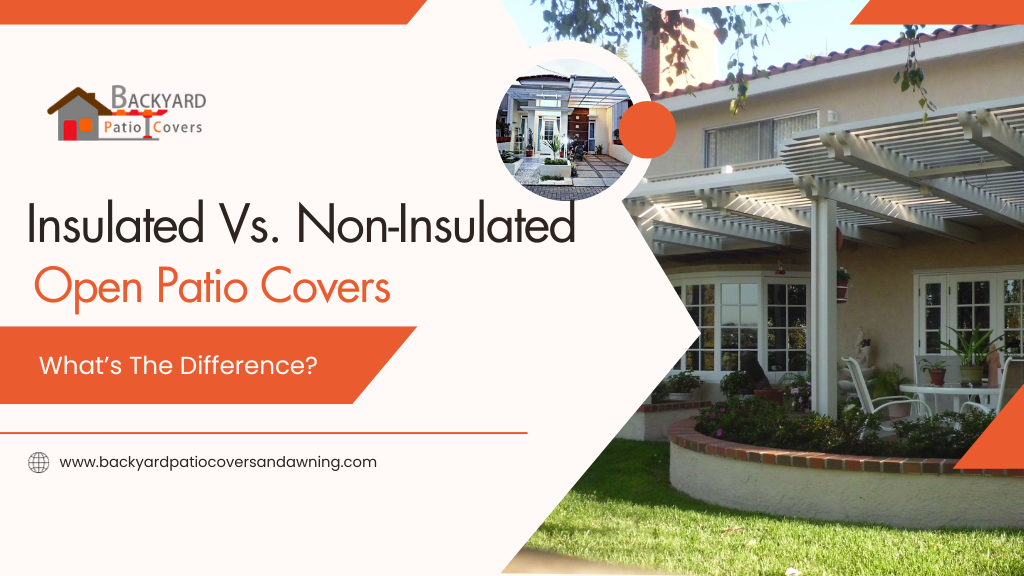When it comes to enhancing your outdoor living space, patio covers are a popular choice. They provide shade, protection from the elements, and a comfortable area for relaxation and entertainment. However, not all open patio covers in Tustin are created equal. One significant consideration when selecting a patio cover is whether to opt for an insulated or non-insulated design. In this comprehensive guide, we will explore the key differences between insulated and non-insulated patio covers to help you make an informed decision for your outdoor oasis.
Understanding Insulated Patio Covers
Insulated patio covers are designed with added layers of material that provide thermal insulation. These covers typically consist of a sandwich-like structure with an insulated core material, often made of foam or another insulating material, sandwiched between two outer layers. The insulation serves several key purposes:
-
Temperature Control
One of the primary benefits of an insulated patio cover is its ability to regulate temperature. The insulating layer helps to reduce heat transfer, keeping the area beneath the cover cooler in hot weather and warmer in cold weather. This temperature control contributes to a more comfortable outdoor experience year-round.
-
Energy Efficiency
Because insulated patio covers help maintain a consistent temperature, they can also contribute to energy savings. With a more comfortable outdoor space, you’re less likely to rely on fans, heaters, or air conditioning, ultimately reducing your energy consumption and utility costs.
-
Noise Reduction
Insulated open patio covers in Tustin can dampen outdoor noise to some extent. The insulation absorbs and reduces sound, creating a quieter and more peaceful environment for relaxation and conversation.
-
Durability
The added insulation in these covers can enhance their durability. It provides protection against the elements, preventing issues such as warping, cracking, or fading that may occur over time with non-insulated covers.
Exploring Non-Insulated Patio Covers
On the other hand, non-insulated patio covers, also known as lattice or pergola-style covers, consist of an open framework of posts and beams without additional insulating layers. These covers are appreciated for their classic and airy appearance and provide partial shade and protection. Here are some key aspects of non-insulated patio covers:
-
Aesthetic Appeal
Non-insulated patio covers are favored for their elegant and open design. They allow filtered sunlight to pass through, creating beautiful patterns of light and shadow on the ground beneath. This design aesthetic can complement various architectural styles.
-
Partial Shade
While non-insulated patio covers do provide shade, they offer partial shade. This means they may not provide as much relief from intense sunlight as insulated covers. However, they are ideal for homeowners who want some sun exposure while still enjoying protection from the elements.
-
Customization Options
Non-insulated patio covers can be highly customizable. You can choose from various materials, including wood, aluminum, or vinyl, and opt for different colors and finishes to match your home’s exterior and your personal style.
-
Affordability
Non-insulated patio covers are generally more budget-friendly than their insulated counterparts. If cost is a significant consideration, a non-insulated design may be the preferable choice.
Choosing the Right Patio Cover for You
The decision between an insulated and non-insulated patio cover ultimately depends on your specific needs, preferences, and priorities. Here are some factors to consider when making your choice:
-
Climate
Consider the climate in your region. If you experience extreme temperatures or frequent weather fluctuations, an insulated patio cover may be a wise investment to ensure year-round comfort.
-
Intended Use
Think about how you plan to use your outdoor space. If you want a versatile space that you can enjoy regardless of the weather, an insulated patio cover provides more flexibility.
-
Budget
Your budget plays a crucial role in your decision. While insulated open patio covers in Tustin offer numerous benefits, they tend to be more expensive upfront. Non-insulated covers are a cost-effective option that can still provide valuable shade and shelter.
-
Aesthetic Preferences
Consider the aesthetic you desire for your outdoor space. Non-insulated covers are known for their charming and open design, while insulated covers offer a more solid and substantial appearance.
-
Long-Term Goals
Think about your long-term plans for your outdoor area. If you intend to invest in heating or cooling solutions for your patio, the energy efficiency of an insulated cover may be advantageous.
Conclusion
In the choice between insulated and non-insulated open patio covers in Tustin, there is no one-size-fits-all answer. Both options offer unique advantages, and the decision should align with your specific needs and preferences. Whether you prioritize temperature control, energy efficiency, budget considerations, or aesthetics, there’s a patio cover solution that can transform your outdoor space into a comfortable and inviting retreat. By understanding the key differences between insulated and non-insulated covers, you can make an informed choice that enhances the beauty and functionality of your outdoor oasis for years to come.

